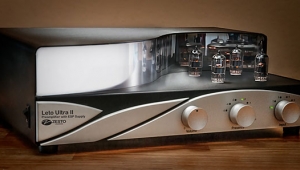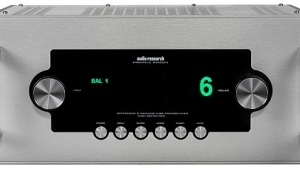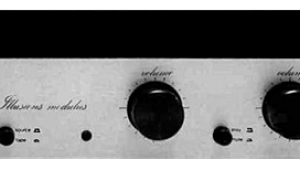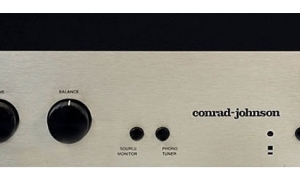| Columns Retired Columns & Blogs |
Blue Circle BC3 Galatea line-level preamplifier Measurements
Sidebar 3: Measurements
I took off the cover to free the board suspension before measuring and was impressed by the neatness of the point-point wiring. Only one tag strip is used, most wiring consisting of the component lead-out wires. That other thing that impressed me was the two Shallco stepped attenuators behind the front panel: these appear to switch both the series and the shunt resistors, minimizing the number of components in the signal path.
What impressed me less was the sharing of the two 6922 tubes between the channels. While Blue Circle promotes the Galatea as being "dual-mono," this is not true. The used of shared tubes does compromise channel separation (fig.1), due to capacitive coupling. But with audioband crosstalk remaining below -55dB, and decreasing at the usual 6dB/octave with decreasing frequency, this will not have subjective consequences.

Fig.1 Blue Circle Galatea, channel separation with volume control at its maximum, from top to bottom: L-R, R-L (10dB/vertical div.).
The Galatea inverted polarity and its source impedance was a little higher than specified, at 200 ohms in the midrange and treble, which is still low in absolute terms. However, at low frequencies, the impedance rose to 633 ohms (20Hz), due to the presence of a series coupling capacitor. The matching power amplifier should have an input impedance of at least 10k ohms if the low bass is not to be rolled-off. The lower trace to the left of fig.2, for example, shows what happens when the Galatea drives the punishing 600 ohm load. The low frequencies, which are flat down to well below 10Hz into 100k ohms, roll off early into 600 ohms, reaching -2dB at 20Hz. There is some dependency between the ultrasonic response and the setting of the volume control. However, even in the worst case, fig.1 shows that the response is maintained to well above 20kHz.
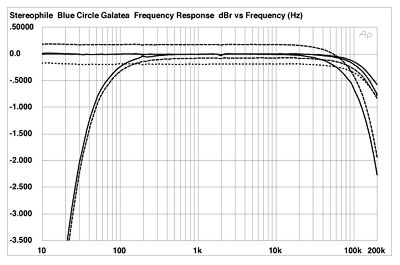
Fig.2 Blue Circle Galatea, frequency response at 1V output with volume control at maximum gain into 100k ohms (top above 20kHz), at 12:00 into 100k ohms (bottom above 20kHz), and at maximum gain into 600 ohms (bottom below 200Hz). (0.5dB/vertical div.)
Because the input signal is fed directly to the stepped attenuators, the Galatea's input impedance depends very much on the volume control setting. With the control set to its maximum setting, the input impedance was a very respectable 93.4k ohms. But reducing the volume setting to 12:00, which will be around the worst-case, the preamp's input impedance (at 1kHz) dropped to a low 1840 ohms. Some source components might have a hard time driving this load.
As is usual with a simple tube circuit, there is way too much voltage gain available. With the Blue Circle's volume control wide open, a whopping 25.1dB is available, which will drive any power amplifier well into clipping with a typical line-level source. Fortunately, the design of the volume control doesn't impose any sonic penalty for its being used at lower settings. There is not an exact unity-gain setting, this falling between the 1:00 and 2:00 positions of the volume-control knobs.
The steps between the control's settings were an accurate 2dB all the way down to -50dB, with then two 3dB steps, one 4dB step, one 6dB step, and the final position offering -90dB rather than a full mute. Though Chip didn't have a problem setting a volume with which he was comfortable, I have found in the past that 2dB steps are a little on the high side. I would have preferred to see 1dB or 0.5dB steps around the control's central settings, where it would most likely be used. There was also a persistent but negligible 0.09dB channel imbalance on the review sample, which is probably due to the intrinsic character of the gain-stage tube.
Despite its simplicity, the Galatea's circuit is very linear, measured THD+noise at 2V into 100k ohms remaining below 0.07% across the audioband, with only a very slight rise apparent above 20kHz (not shown). Plotting the THD+N percentage into three different loads, 100k, 10k and 600 ohms (fig.3), reveals that the measured distortion is actually lower into 10k than it is into 100k ohms, and that the maximum output voltage (at 1% THD+N) is 32V (100k load) and 20V (10k) both an order of magnitude higher than is necessary in the real world. Just 550mV is available into 600 ohms, however, reinforcing the idea that the Galatea should not be used into loads much less than 10k ohms.

Fig.3 Blue Circle Galatea, distortion (%) vs output voltage at 1kHz into 100k ohms (right), into 10k ohms (middle) and into 600 ohms (left).
As shown by fig.4, what harmonic distortion is present in the Blue Circle's output is the subjectively innocuous second harmonic. And subjecting the preamp to the high-frequency twin-tone torture test resulted in just 0.06% of the 1kHz difference component (fig.5), which is excellent performance.

Fig.4 Blue Circle Galatea, spectrum of 50Hz sinewave, DC-1kHz, at 2V into 100k ohms (linear frequency scale).

Fig.5 Blue Circle Galatea, HF intermodulation spectrum, DC-22kHz, 19+20kHz at 2V into 100k ohms (linear frequency scale).
The Galatea's circuit may be simple, but it does not compromise the measured performance in any subjectively meaningful way, as long as it is used with appropriate source components and power amplifiers. Nice one, Blue Circle.—John Atkinson
- Log in or register to post comments







